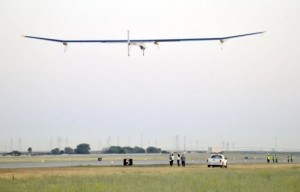
The Solar Impulse plane takes off from Moffett Field NASA Ames Research Center in Mountain View, California, May 3, 2013 (AFP, Josh Edelson)
MOFFETT AIRFIELD, California—The first-ever manned airplane that can fly by day or night on the sun’s power alone soared over the western United States late Friday on the first leg of cross-country journey.
Solar Impulse, piloted by Swiss adventurer Bertrand Piccard, left the runway in northern California at 6:12 am (1312 GMT) against the backdrop of a golden morning sunrise, in what a mission control operator called a “perfect takeoff.”
Flying quietly and slowly at an average speed of about 30 miles (49 kilometers) per hour, the plane was scheduled to arrive in Phoenix, Arizona, around midnight (0700 GMT) under cover of darkness.
As of about 0630 GMT, the plane was circling over Phoenix, going down slowly to save energy as it prepared to land, Solar Impulse said on its website.
A dashboard showing the live speed, direction, battery status, solar generator and engine power, along with cockpit cameras of both Piccard and his view from the plane, were online at live.solarimpulse.com.
The US itinerary allows for up to 10 days at each stop in order to showcase the plane’s technology to the public. Other stops are planned for Dallas, Texas, and the US capital Washington, before wrapping up in New York in early July.
That will allow two pilots — Piccard and his co-founder, Swiss engineer and ex-fighter pilot Andre Borschberg — to share duties and rest between flights.
The project aims to showcase what can be accomplished without fossil fuels, and has set its “ultimate goal” as an around-the-world flight in 2015.
The plane has four electric motors and runs on energy provided by 12,000 solar cells.
Longer trips have already been successfully completed by the plane, which made the world’s first solar 26-hour day and night trip in 2010.
However, the cockpit has room for just one pilot, so even though the plane could likely make the entire US journey in three days, Piccard decided it would be easier to rest and exchange flight control with Borschberg at the stops.
Solar Impulse was launched in 2003.
The plane can fly at night by reaching a high elevation of 27,000 feet (8,230 meters) and then gently gliding downward, using almost no power through the night until the sun comes up to begin recharging the aircraft’s solar cells.
The US journey is being billed as the plane’s first cross-continent flight. The aircraft completed its first intercontinental journey from Europe to Africa in June on a jaunt from Madrid to Rabat.
The slim plane is particularly sensitive to turbulence and has no room for passengers, but Piccard has insisted that those issues are challenges to be met in the future, rather than setbacks.
“Instead of speaking of the problems, we want to demonstrate solutions,” Piccard said as he flew toward Phoenix, stressing that renewable technologies already exist and are well known to science.
“Now we need to put them on a big scale everywhere in our daily life.”